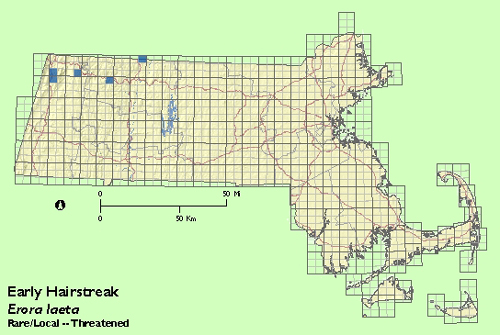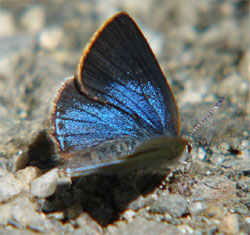Find a Butterfly
Early Hairstreak
Erora laeta
Named
Edwards, 1862

Taxonomy & Nomenclature
The Arizona Hairstreak (Erora quaderna), once considered a western race of laeta, is now generally considered a distinct species.
Identification
Wingspan: 3/4 - 1". Underwing pattern unmistakable: pale silvery green ground color, delicately marked on the hind wing with two rows of red dots and crescents. Irridescent blue above, and therefore could be mistaken for a "blue". See photos for difference between males and females.
Distribution
Sporadic in northern and mountainous regions of eastern North America from Wisconsin east along the U.S./Canadian border to Nova Scotia and south in the Appalachians to northeastern Alabama and northwestern Georgia. In New England it has been recorded in Maine, Vermont, New Hampshire, and Massachusetts.
Status in Massachusetts
As everywhere throughout its range, very local and usually regarded as very rare, but with increased field work it has proven to be locally and seasonally common at least in some years. The apparent fluctuations in its populations are poorly understood. During the atlas period, it was recorded in eight towns, all in Berkshire and Franklin Counties: Williamstown, Florida, Lenox, Bernardston, New Ashford, Buckland, Montague and Sheffield. Most of these records are of single individuals. Maximum: 29, Mt. Greylock (Berkshire Co.), 14 June 1993. Early Hairstreak is listed as a Threatened species under the Massachusetts Endangered Species Act.
First recorded by Scudder on Mt. Greylock, 30 June 1882. Then unrecorded for 84 years. Summary of first recent records as follows:23 May 1966, Pittsfield (Berkshire Co.) and 28 May 1988, Lenox (Berkshire Co.) (specimens in Wendell collection); 22 May 1992, Mt. Greylock (Berkshire Co.), E. Dunbar; 12 June 1988, Florida (Berkshire Co.); 13 June 1988, Williamstown and New Ashford (Berkshire Co.); 30 June 18??, Williamstown (Berkshire Co.); 7 July 1988, Montague (Franklin Co.); 10 July 1988, Bernardston (Franklin Co.); and 7 August 1987, Sheffield (Berkshire Co.).
Listed as State Threatened in the Massachusetts Endangered Species Act.

Flight Period in Massachusetts
Possibly two flights. If so, the dates are poorly defined due to the scarcity of records. Based on what we know, a reasonable guess would be mid-May to the third week in June and early July to mid August. Extreme dates: 22 May 1992, Mt. Greylock (Berkshire Co.),; the latest 7 August 1987, Sheffield (Berkshire Co.).
Larval Food Plants
American Beech (Fagus grandifolia). In the lab, laeta has also been reared on Beaked Hazelnut (Corylus cornuta), White Oak (Quercus alba) and willow (Salix,sp.). The caterpillars are leaf skeletonizers in early instars and feed on whole leaves and fruits when mature.
Adult Food sources
Early Hairstreaks have been seen nectaring on Steeplebush, dewberry, fleabane, Ox-eye Daisy*, New Jersey Tea and Butterfly Weed. In addition, they have been found on brambles (Rubus, sp.) at Mt. Greylock. Males and females are often seen "puddling", i.e. perched on damp soil on roads, stream banks and the like.

Habitat
Often stated as beech forest in the literature, but as records of occurrence accumulate, the true habitat appears to be northern hardwood forest (and its equivalent in the southern mountains) where both beech and Beaked Hazelnut are typically present among Sugar Maple, Red Oak, American Basswood and other deciduous tree species. It may spend much of its time in the forest canopy, but is most often seen in open forest glades with an abundance of nectaring plants or along sunlit, forest-lined dirt roads.
W.H. Edwards, who described the species in 1862 found one of his (West Virginia) specimens at the bottom of a freshly dug fence post hole!
Life Cycle
Still imperfectly known. EGG: Pale green OVIPOSITION: Eggs are laid singly on the undersides of leaves (lab observation). LARVA: Pale yellowish green to rufous with reddish spots on thorax and front end of the abdomen. CHRYSALIS: Brown with darker spots. PUPATION: Little known; does not make a leaf nest. OVERWINTERING STAGE: Probably as chrysalis.
Based on the behavior of its congener, the Arizona Hairstreak, and observations of Early Hairstreaks heading for the treetops when disturbed, it seems probable that male laetas perch high atop the forest canopy awaiting females patrolling the same habitat. This might explain why this butterfly is seen so infrequently. Under certain conditions both males and (mainly) females are found at ground level, sometimes commonly. Whether this occurs due to population explosions or because of extreme heat in the canopy or other ambient conditions (Bowers, 1978) remains unclear.
Notes
This "charming object" (as Scudder called it) has long been sought by American lepidopterists with the same fervor and in an atmosphere of enveloping mystery reminiscent of the search for the Holy Grail. The emotion of finding one has been expressed in a number of journal articles, but never better than by the redoubtable Scudder, who, clapping his net over the first one he had ever seen, "shouted triumphantly,
How have, I say, mine eyes been blessed made
By looking on thee in the living day."
Account Author
Chris Leahy



